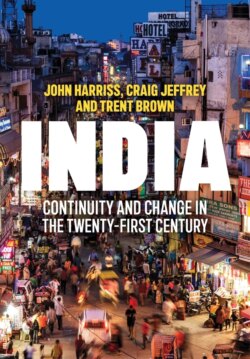Читать книгу India - Craig Jeffrey - Страница 25
Accelerating Growth in the 1980s
ОглавлениеAs we have argued, the 1980s saw an acceleration in the rate of economic growth over the trend line of the previous three decades (see table 2.1), even if it was only a ‘nascent recovery’ according to Kar and Sen. We referred earlier to the proximate factors that brought about capital accumulation and the improvements in TFP that are clearly observed in data on the 1980s. But what happened to bring about the changes that took place in patterns of investment, pushing up levels of private investment, and encouraging more investment in machinery?
The nature of state–business relationships began to change when Mrs Gandhi was returned to power in the general election of January 1980, after the collapse of the short-lived Janata regime. Several leading scholars argue that government attitudes changed at this time from being anti- to pro-business (De Long 2003; Rodrik and Subramanian 2005; and Kohli 2006a, 2006b). Kohli says, ‘just after coming to power in January 1980 … Indira Gandhi let it be known that improving production was now her top priority. In meeting after meeting with private industrialists, she clarified that what the government was most interested in was production’ (2012: 30–1). Rodrik and Subramanian, in their joint work, argued that a change in the attitudes of the Congress political elite towards business had a big impact. A much more pro-business orientation on the part of political leaders made for significantly higher growth rates, because India had, until that time, performed so poorly in relation to the quality of its economic institutions – which meant small changes brought about big shifts. The change of attitude may have been a matter of political calculation on Mrs Gandhi’s part – promising to strengthen her hand against the threat still posed by the opposition – but it started to establish a more collaborative relationship between state and business: ‘the Indian state clearly signaled to domestic capitalists its intention to credibly commit to an environment where private enterprise would be supported and growth-enhancing policies followed’ (Kar and Sen 2016: 41).
This trend was further accentuated under the government headed by Rajiv Gandhi, who came to power at the end of 1984, in the general election that followed the assassination of his mother in October that year. Gandhi was interested in new technologies, and sought to encourage new industries, bringing in entrants to the business elite. Non-traditional business groups began to emerge, especially in western India and in the south. And, though they were modest (‘half-hearted’, as one of us put it at the time: Harriss 1987), Rajiv Gandhi’s government did introduce some reforms of industrial and trade policy, opening them up, even if only a little. We noted earlier the implications of the softening of import restrictions for the price of capital equipment for Indian investors. The consequence of changing political attitudes, of the advent of new business elites, and of the reforms that were implemented, was that by the late 1980s the deals environment had become both more ordered and more open, and this is seen by Kar and Sen as having been ‘the crucial enabling factor behind the increase in private investment in equipment’ (2016: 41).
These arguments are not universally accepted. Arvind Panagariya, whose analysis of phases of growth we referred to earlier (see table 2.3) argued that only in the three years from 1988–89 to 1990–91 was there a distinctively higher growth rate, and that this was the fruit of the modest, piecemeal reforms that had been pursued to that time. The real break in the growth trend came only with more thorough-going market-friendly reforms that were launched in 1991 (Panagariya 2008). Panagariya, and others too, also thought that the growth of the 1980s depended upon unsustainable fiscal expansion. Large fiscal deficits were run up, government debt expanded hugely through the decade, exerting a big stimulus to demand – but in a way that was held to be unsustainable. Kotwal et al. (2011), from their review of these arguments and the evidence for them, reach the judicious conclusion that all of the factors that are referred to may have played a part. None of the other explanations, however, addresses the crucial question of how the settlement between business and political elites changed. The more ordered deals environment that Kar and Sen discern in the 1980s was then extended in the 1990s.
